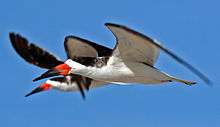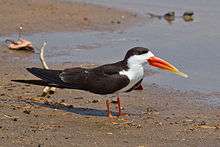Rynchops
The skimmers, forming the genus Rynchops, are tern-like birds in the family Laridae. The genus comprises three species found in South Asia, Africa, and the Americas. They were formerly known as the scissorbills.[1]
| Skimmers | |
|---|---|
_in_flight.jpg) | |
| Black skimmer (R. niger) skimming | |
| Scientific classification | |
| Kingdom: | Animalia |
| Phylum: | Chordata |
| Class: | Aves |
| Order: | Charadriiformes |
| Family: | Laridae |
| Genus: | Rynchops Linnaeus, 1758 |
| Species | |
| |
The three species are the only birds with distinctive uneven bills, where the lower mandible is longer than the upper. This remarkable adaptation allows them to fish in a unique way, flying low and fast over streams.[2] Their lower mandible skims or slices over the water's surface, ready to snap shut any small fish unable to dart clear. The skimmers are sometimes included within the gull family Laridae but separated in other treatments which consider them as a sister group of the terns.[3] The black skimmer has an additional adaptation and is the only species of bird known to have slit-shaped pupils.[4] Their bills fall within their field of binocular vision, which enables them to carefully position their bill and capture prey.[5] They are agile in flight and gather in large flocks along rivers and coastal sand banks.[6]
They are tropical and subtropical species which lay 3–6 eggs on sandy beaches. The female incubates the eggs. Because of the species' restricted nesting habitat the three species are vulnerable to disturbance at their nesting sites. One species, the Indian skimmer, is considered vulnerable by the IUCN due to this as well as destruction and degradation of the lakes and rivers it uses for feeding.[7]
As in later editions of the works of Linnaeus, the correct spelling (from the Greek words ῥύγχος and ὤψ, together meaning "beak-face") should be rhynchops and this is often adopted. However, the misspelling rynchops was the one first published by Linnaeus and continues to be more commonly used.[8] Similarly, the gender of the Greek and Roman words is feminine and the genus was originally treated as such (R. nigra) but Rynchops is now usually treated as a masculine noun (R. niger).
Species
| Skimmer species | |||
|---|---|---|---|
| Common and binomial names | Image | Description | Range |
| Black skimmer (Rynchops niger) |
 |
||
| African skimmer (Rynchops flavirostris) |
 |
||
| Indian skimmer (Rynchops albicollis) |
 |
||
References
- "scissorbill, n.", Oxford English Dictionary, Oxford: Oxford University Press, 2014.
- Mariano-Jelicich, R; Favero, M.; Silva, M.P. (February 2003). "Fish Prey of the Black Skimmer Rynchops Niger at Mar Chiquita, Buenos Aires Province, Argentina" (PDF). Marine Ornithology. 31: 199–202. Retrieved 2009-06-29.
- Fain MG & Peter Houde (2007). "Multilocus perspectives on the monophyly and phylogeny of the order Charadriiformes (Aves)". BMC Evolutionary Biology. 7: 35. doi:10.1186/1471-2148-7-35. PMC 1838420. PMID 17346347.
- Zusi, RL & D Bridge (1981). "On the Slit Pupil of the Black Skimmer (Rynchops niger)" (PDF). Journal of Field Ornithology. 52 (4): 338–340.
- Martin, G.R., Rojas, L.M., and McNeil, R. (2007). "Vision and the foraging technique of Skimmers (Rynchopidae)". Ibis. 149 (4): 750–757. doi:10.1111/j.1474-919X.2007.00706.x.CS1 maint: multiple names: authors list (link)
- Fusco, P.J. "Connecticut Wildlife Archived 2009-09-14 at the Wayback Machine." Connecticut Department of Environment Protection Bureau of Natural Resources – Wildlife Division. May–June 2006. Accessed 2009-06-29.
- "Large dams and barrages are an increasing threat to wetland-dependent birds". BirdLife International. Retrieved 21 February 2014.
- Amaral, A do (1967). "Comment on the gender of names ending in -ops". Bulletin of Zoological Nomenclature. 24 (1): 2.
External links
| Wikimedia Commons has media related to Rynchops. |
- Skimmer videos on the Internet Bird Collection